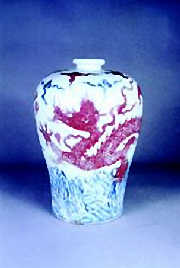 Location:Jingdezhen, East China's Jiangxi Province
Location:Jingdezhen, East China's Jiangxi Province
Period:Ming and Qing dynasties (1368-1911)
Excavation period: October 2002-January 2003, October-December 2003
A joint team of researchers from Peking University, the Jiangxi Provincial Cultural Relics Archeological Research Institute and Jingdezhen Porcelain Archeological Research Institute, led by Liu Xinyuan
 Findings
Findings
From 2002 to 2003, Chinese archeologists carried out two excavations at the royal kiln site in Zhushan of Jingdezhen, East China's Jiangxi Province, unearthing wall remains, kiln ruins and house foundations in an area of 788 square meters.
A group of six gourd-shaped kilns were discovered arranged in a straight line. The kilns, dating back to the Hongwu to Yongle period of the Ming Dynasty (1368-1644), were all built with wedge-shaped red bricks and consisted of a kiln door, fire chamber, front chamber, rear chamber and protective walls. This is the first time that gourd-shaped kilns were discovered in royal kilns.
Large quantities of porcelain craftworks were harvested at the site, such as bottles, pots, jars, bowls, plates, cups, flowerpots and boxes, to name a few, most with inscriptions. Various types of porcelain from the early and mid Ming Dynasty were the pride of the excavation, which produced some of the rarest porcelain in history.
